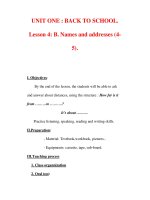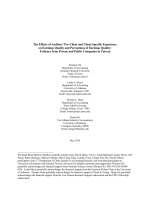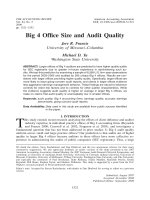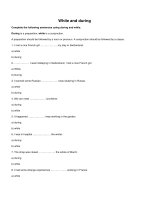Ch 4 Notes Sensation and Perception
Bạn đang xem bản rút gọn của tài liệu. Xem và tải ngay bản đầy đủ của tài liệu tại đây (2.67 MB, 103 trang )
Sensation and Perception
Unit 4
AP Psychology
The Basics
• We do not actually experience the world
directly, but instead we experience it through a
series of “filters” we call senses.
• The study of these sense and their effect on our
behavior is called sensory psychology.
Sensation
• Sensation: The process by which a stimulated
receptor (eyes, ears…) creates a pattern of
neural messages that represent the stimulus in
the brain, giving rise to our initial experience of
the stimulus.
Our Senses
• You will notice that all of our sense organs
are very much alike.
▫ They all transform physical stimulation (such as light
waves or sound waves) into the neural impulses what
give us sensations (such as light and dark).
Perception
• Perception: A mental process
that elaborates and assigns
meaning to the incoming
sensory patterns.
▫ Perception creates an interpretation of sensation.
Do you see faces or vases?
Sensation and Perception
• Perception is essentially an interpretation
and elaboration of sensation. Therefore,
sensation refers to the initial steps in the
processing of a stimulus.
These pictures look
fairly similar
The True Picture
The Famous Mona Lisa…Frown or Smile
The Famous Mona Lisa…Frown or Smile
Big Idea
• Although it seems the brain
interacts directly with the
outside world, it does not.
• The brain senses the world
indirectly because the sense
organs convert stimulation into
the language of the nervous
system: neural messages.
▫ In short, the brain never receives
stimulation directly from the outside world.
Transduction: Changing Stimulus to Sensation
• In all the sense organs, it
is the job of sensory
receptors to convert
incoming stimuli
information into
electrochemical signals—
neural activity.
• Transduction: The
sensory process that
converts energy, such as
light or sound waves, into
the form of neural
messages.
Transduction
with Hearing
• The neural impulse carries a
code of the sensory event in a
form that can be further
processed by the brain.
Light Waves
Neural Signals
The Process of Transduction
• Transduction begins with the detection by a
sensory neuron of a physical stimulus.
• When the appropriate stimulus reaches the
sense organ, it activates specialized neurons
called receptors.
• The receptors respond by converting their
excitation into a nerve signal.
▫ Think of this as the way a bar-code reader converts a
series of lines into an electrical signal that a computer
can match with a price.
A Simple Example
• Close both of your eyes. Press gently in
the corner of one eye. You should “see”
a pattern caused by pressure of your
finger, not by light.
• These light sensations are phosphenes,
or visual images caused by fooling
your visual system into thinking it
sees light.
Sensory Adaptation
• Sensation is critically influenced
by change. Thus, our sense
organs are change detectors.
• Their receptors specialize in
gathering information about
new and changing events.
Sensory Adaptation
• Sensory adaptation is the diminishing
responsiveness of our sensory systems
to prolonged stimulation.
• Unless it is quite intense or painful,
stimulation that persists without
change in intensity usually shifts to
the background of our awareness.
▫ Until now, many of you are probably unaware that your sense of touch had
adapted to the pressure of the chair against your legs.
Thresholds
• What is the weakest stimulus
that an organ can detect?
• Absolute threshold: The level of
stimulus necessary for a
stimulus to be detected.
▫ Operational definition of absolute threshold: The presence or
absence of a stimulus is detected correctly half the time over
many trials.
• Because there is a fuzzy line between detection and
nondetection, a person’s absolute threshold is not
necessarily absolute.
• It varies continually with our mental alertness and
physical condition
Sense Modality
Detection of Threshold
Light
A candle flame at 30 miles on a dark, clear night.
Sound
The tick of a mechanical watch under quiet conditions at
20 feet.
Taste
One teaspoon of sugar in two gallons of water.
Smell
One drop of perfume diffused into the entire volume of a
three-bedroom apartment.
Touch
The wing of a bee falling on your cheek from a distance
of one centimeter.
Thresholds
• Difference thresholds: The smallest
amount by which a stimulus can be
changed and the difference be
detected, half of the time.
• Think about when you are
watching TV and a commercial
comes on. Can you tell a difference?
Just Noticeable Difference
• Just Noticeable Difference (JND):
The minimal amount of change in
the signal that is still
recognizable.
• Just noticeable difference, JND
and difference threshold are used
interchangeably.
Laws of Sensation
• Weber’s Law: The size of JND is proportional to
the intensity of the stimulus; the JND is large
when the intensity of the stimulus is high.
• Fechner’s Law: Expresses the relationship
between the actual magnitude of the stimulus
and its perceived magnitude.
• Steven’s Power Law: A law of magnitude that is
more accurate than Fechner’s law and covers a
wider variety of stimuli.
Signal Detection Theory
• Signal detection theory says that
sensation depends on the
characteristics of the stimulus, the
background stimulation and the
detector.
• This theory takes the observer’s
characteristics into account and says
that stimulus judgment often happens
outside of consciousness.
Signal Detection Theory
• Signal detection theory recognizes
that the observer, whose physical
and mental characteristics are
always in flux, must compare a
sensory experience with everchanging expectations and
biological conditions.









